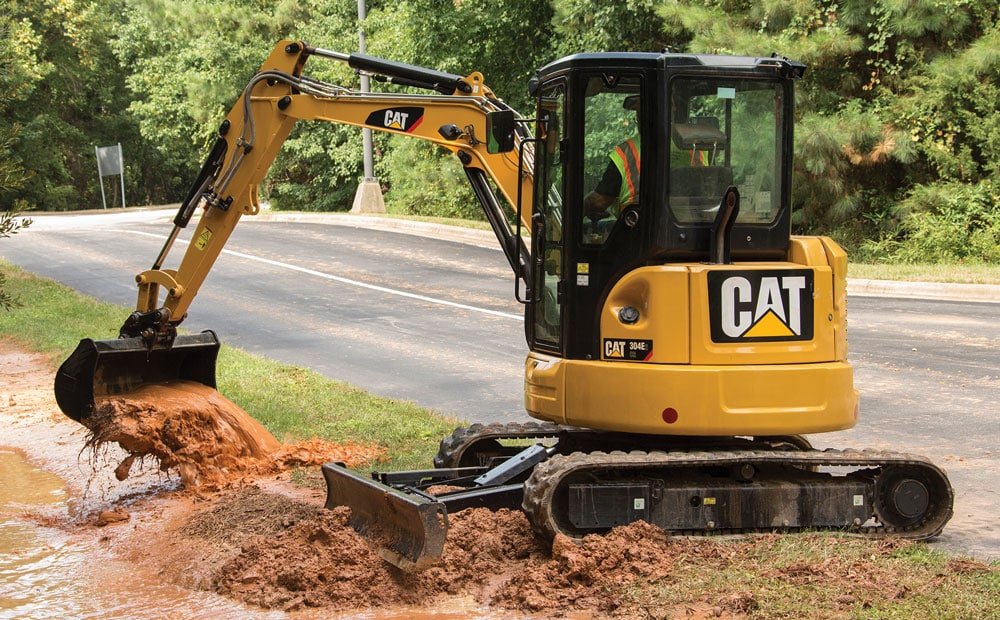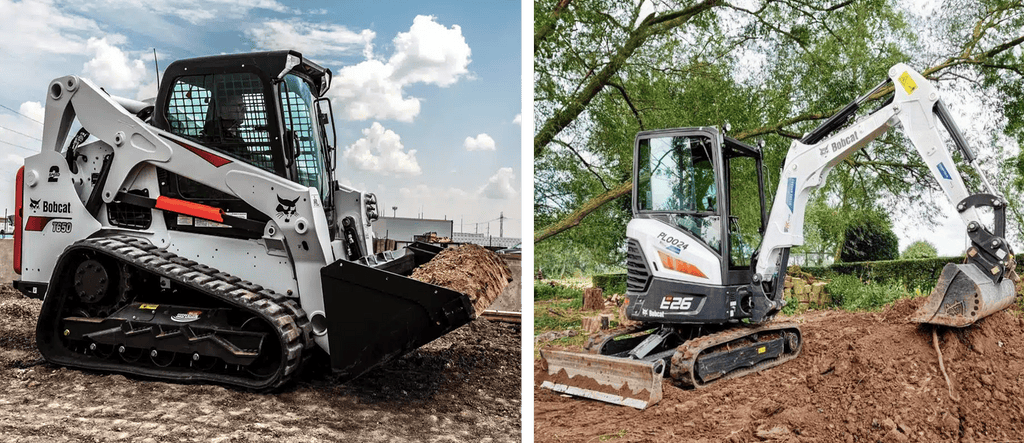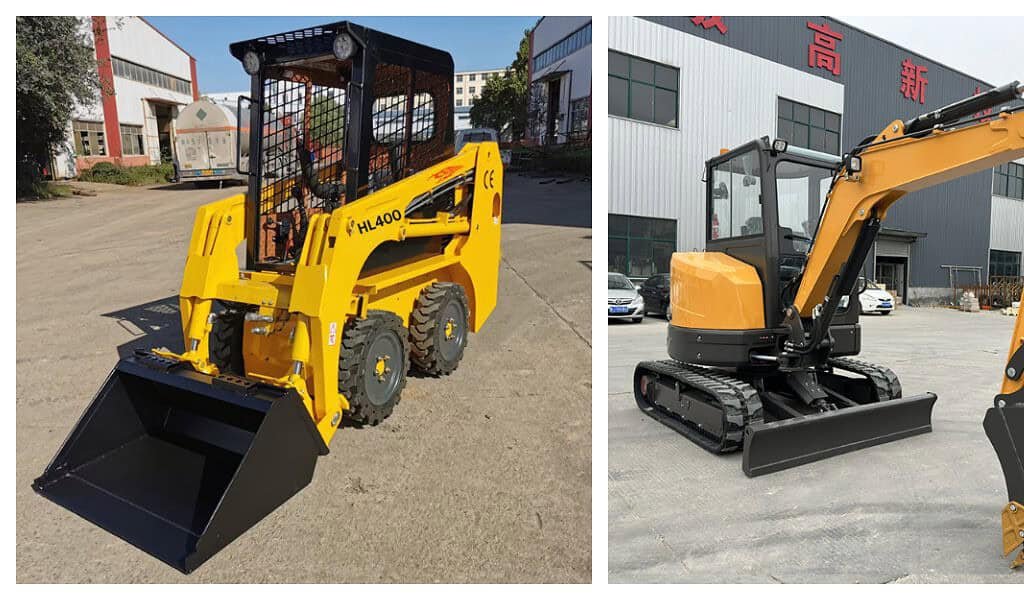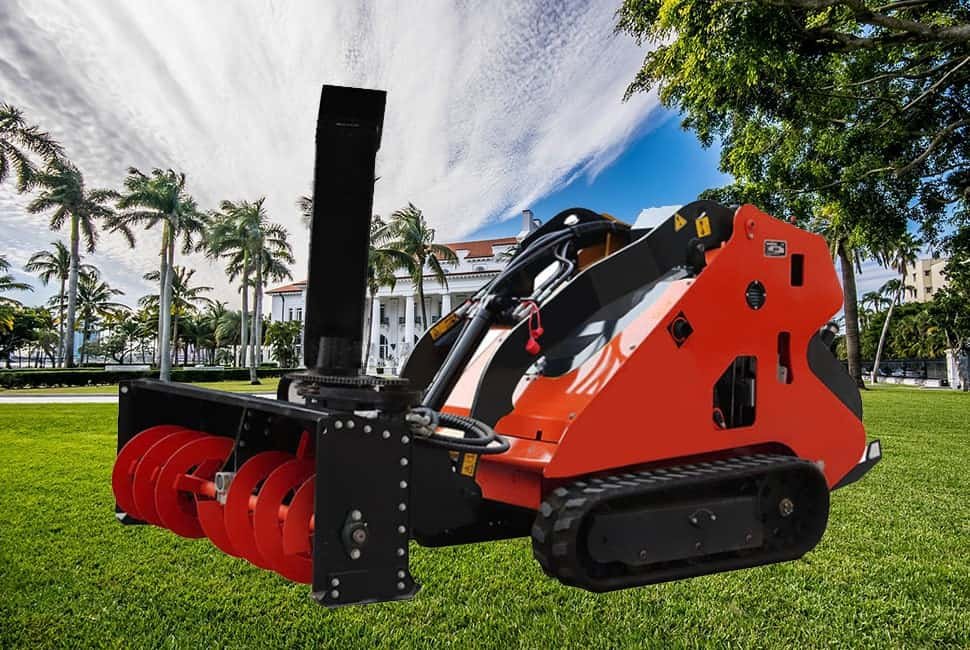When it comes to heavy-duty work like land clearing, digging, or hauling, choosing the right equipment is crucial. The wrong choice could result in delays, higher costs, and even safety risks. This article compares skid steer vs mini excavator to help you decide which one is best suited for your next project.
Skid steers and mini excavators each have their unique advantages, making them ideal for different types of tasks. Whether you’re clearing land, digging trenches, or moving materials, understanding the differences will help you make a more informed decision on the right equipment.
If you’re still unsure which equipment is best for your project, let’s dive deeper into their features, strengths, and ideal use cases.
What is a Skid Steer and What is it Used For?
A skid steer loader is a highly versatile and compact piece of construction equipment, engineered to tackle an extensive array of tasks with precision and efficiency. Its compact design and superior maneuverability render it the perfect choice for navigating tight spaces and completing tasks swiftly.
These machines have earned a reputation for their remarkable mobility and adaptability. Equipped with an assortment of attachments, skid steers can effortlessly transition between various roles, such as grading surfaces, clearing snow, enhancing landscapes, and even lifting and transporting materials.

A standout feature of skid steers is their capacity to thrive in confined quarters. This attribute makes them an excellent fit for construction projects with limited space or agricultural endeavors in narrow fields. Their wheeled configuration allows them to swiftly and smoothly traverse uneven terrain, which is particularly beneficial for tasks like clearing debris, spreading gravel, or handling heavy loads. Their agility and robustness make skid steers indispensable tools in a variety of work environments.
What is a Mini Excavator and How Does it Differ from a Skid Steer?
Mini excavators are smaller versions of their full-sized counterparts and are specifically designed for digging and moving soil or heavy materials in a controlled and precise manner.
Mini excavators have the ability to dig deeper, lift heavier loads, and operate with greater precision than skid steers. They are best suited for projects that require digging, trenching, or working in tight or uneven terrain.

Mini excavators excel in jobs where digging depth, stability, and precision are crucial. They are commonly used for tasks like digging foundations, trenches, and holes for utility installation. Unlike skid steers, which are better suited for loading and hauling, mini excavators are engineered to provide more power and control during the digging process, especially when dealing with heavy or dense soil.
Skid Steer VS Mini Excavator Operational Comparison
When it comes to operations, skid steers and mini excavators differ significantly in their performance, handling, and functionality on the job site.
Skid steers are known for their excellent maneuverability and speed, making them ideal for tasks that require quick movement and agility. Mini excavators, on the other hand, are built for heavy-duty digging, with greater stability and power for tasks requiring deep trenching or excavation.
Skid steers typically offer superior mobility, which makes them ideal for moving quickly around the site, especially in smaller spaces. They can easily switch between different attachments, making them versatile for a variety of tasks. In contrast, mini excavators are more focused on digging and earth-moving tasks. They have a higher lifting capacity, more powerful hydraulics, and can work more efficiently in tasks that require deep digging or precise excavation.
Skid Steer VS Mini Excavator For Clearing Land
Land clearing involves removing trees, shrubs, debris, and other obstacles from a site. Both skid steers and mini excavators can handle land clearing, but they are better suited for different aspects of the task.
Skid steers are ideal for clearing land quickly, particularly when there is a need to move debris or level uneven ground. Mini excavators are better for more detailed work, such as removing stumps or digging out roots.

Skid steers excel in land clearing where quick movement and material handling are necessary. They can be equipped with a range of attachments, such as brush cutters or forestry tools, to efficiently clear the land. Mini excavators, however, are perfect for more precise clearing jobs. They can be used to dig up stubborn tree roots, break through compact soil, or remove larger debris such as rocks and stumps. For projects requiring both quick clearing and detailed excavation, using both machines in tandem can be highly effective.
What Are The Advantages of Using a Skid Steer Over a Mini Excavator?
Mini excavators excel in digging tasks, but skid steers shine in terms of speed, adaptability, and cost-effectiveness. These agile machines offer a distinctive edge in construction and landscaping projects where quick, multifaceted operations are essential.
Skid steers boast unparalleled mobility, enabling them to tackle a diverse range of tasks with the aid of various attachments. They are generally more budget-friendly at the outset compared to mini excavators, making them an attractive option for businesses and contractors. Their design is particularly well-suited for tasks that demand nimble, adaptable performance across diverse terrains.
The flexibility of skid steers is one of their most significant benefits. With the capability to switch attachments swiftly, a skid steer can take on a multitude of roles, from grading and leveling to digging and hauling. This versatility makes it an outstanding choice for projects that necessitate a multifunctional machine. Moreover, skid steers often prove to be more cost-effective than mini excavators, especially for projects that do not demand intensive digging or lifting capabilities.
In summary, skid steers are not just another piece of machinery; they are a versatile workhorse, capable of meeting the demands of a variety of tasks with efficiency and economy, making them an invaluable asset in the right circumstances.
Key Differences Between Skid Steer and Mini Excavator
Skid steers are engineered for swiftness, agility, and adaptability, making them ideal for a variety of light to medium-duty tasks. They are the go-to machines for grading, clearing, and loading materials. Their compact build and exceptional maneuverability enable them to navigate and operate in confined spaces with ease, which is particularly beneficial for landscaping endeavors or smaller-scale construction projects where precision and quick turnaround are key.
On the other hand, mini excavators are powerhouses designed for heavy lifting, accuracy, and the ability to dig deep. They are the preferred choice for tasks that demand meticulous precision and robust stability, such as digging, trenching, and other heavy-duty operations. Mini excavators are often deployed in foundation work, utility installations, and deep excavations in challenging terrains where their strength and accuracy are indispensable.
In essence, skid steers and mini excavators complement each other on the job site. Skid steers excel in quick, multifaceted tasks, while mini excavators deliver the muscle and precision needed for more demanding jobs. Recognizing the strengths of each machine and selecting the right tool for the task at hand can significantly enhance the productivity and outcomes of your projects.
When Should You Use a Skid Steer vs a Mini Excavator?
Choosing between a skid steer and a mini excavator depends on the specific tasks you need to complete and the environment in which you’re working.
If you need a machine for quick and versatile work, such as clearing or hauling, a skid steer is a great option. For more complex tasks like digging or trenching, especially when working with dense soil, a mini excavator will be more efficient.
Skid steers are ideal for projects that require quick, high-mobility tasks in confined spaces. They can work on various types of terrain and switch between different attachments to handle multiple jobs. Mini excavators, on the other hand, are better suited for digging deeper holes or trenches, making them a great choice for foundation work or jobs where precise excavation is needed.
Cost Comparison: Skid Steer vs Mini Excavator
When considering which machine to use, the cost of both the initial purchase and ongoing maintenance should be taken into account.
Skid steers generally have a lower upfront cost and maintenance expenses, making them more accessible for smaller projects or businesses with tighter budgets. Mini excavators typically come with a higher price tag, but they are built for more intensive tasks, which may save money in the long run by reducing labor and time.
While a skid steer’s initial investment may be lower, its versatile attachments can increase costs over time if frequent changes are required. Mini excavators, on the other hand, tend to have higher operating costs but are more efficient for tasks requiring significant digging depth or heavy lifting, thus reducing the time spent on the job site.
Which One Should You Choose for Your Project?
Deciding between a skid steer and a mini excavator depends on your project’s specific needs, the terrain, and the type of work that needs to be done.
For light excavation, material handling, or jobs that require rapid movement, a skid steer is ideal. For heavier digging, precise excavation, or jobs with more demanding conditions, a mini excavator is the better choice.
If you’re working on a small project like landscaping or farm maintenance, a skid steer will provide the flexibility and mobility you need. However, for construction projects requiring deep excavation, trenching, or foundation digging, a mini excavator is the more appropriate tool to get the job done efficiently.
Краткое содержание
Both skid steers and mini excavators have their unique strengths. By understanding their features and the specific needs of your project, you can make the best choice for your work.


